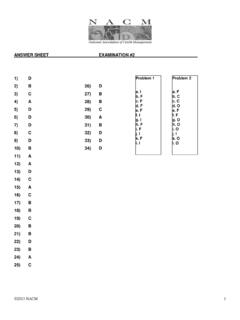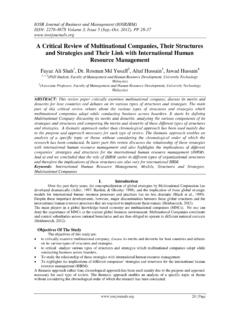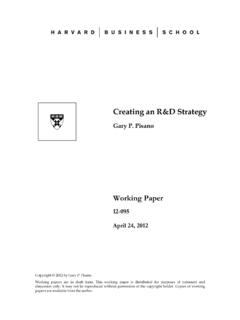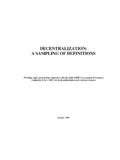Transcription of 3 Organizing the Credit Department - NACM
1 Chapter 3 | Organizing the Credit Department 3-1 Organizing the Credit DepartmentOverviewThe properly organized Credit Department plays a critical role in managing accounts receivable portfolio risk to protect profits, prevent potential losses and help the company sell more products or chapter discusses the role of the Credit Department from an organizational point of view. Proper structur-ing of the Credit Department from a one-person operation to a multi-tiered, multifunctional entity ensures that the role of Credit contributes to the overall success of any company regardless of IDEASA er reading this chapter, the reader should understand: Organizational options for the Credit Department . centralization vs. decentralization . Responsibilities of management.
2 Effective Credit policies and procedures. How to build a strong Credit team. Chapter Outline1. Organizing the Credit Department 3-22. centralization vs. decentralization 3-23. Management Responsibilities 3-54. Business Organization 3-65. Building the Credit Department 3-8 Team 6. Supplementary Material: What is Onboarding? 3-183 THINK ABOUT THIS Q. How do the operations of a business change the structure and function of the Credit Department and vice versa?Q. What is a Credit manager s role in setting Credit policy, hiring and continuing the professional development of the Credit Department s staff?Principles of Business Credit 3-2 Organizing the Credit DepartmentThe nature of a business and its size will determine the structure and staffing of the Credit Department .
3 Unlike most other company operations, the Credit Department tends to remain fairly constant in size and scope of activities during periods of changing business conditions. This is due to increased support needed for full volume sales in good times and for increasing delinquencies when economic times are difficult. A Credit Department may face a greater number of collection problems in a depressed economy when inflation is rising and the money supply is tighter. During prosperous times, new account volumes create more upfront work for the Credit organization of the Department is particularly important; a measure of permanence and stability must be achieved that will ensure that the Department functions under all conditions. Although the organization should not remain static, it is highly desirable to have experienced and capable employees available within the Department .
4 The Credit manager should strive to achieve a balance of newly trained entry-level staff and experienced Credit pro-fessionals. Alternatives exist to accommodate extra heavy workloads. Cross-training of personnel can lead to more flexibility. Accounting Department personnel can be trained to perform routine tasks and called upon as necessary and temporary staff hired or tasks can be outsourced to companies specializing in Credit -related functions such as cash application and dispute vs. DecentralizationAlthough there may be variations among companies, the control and administration functions can usually be classified into two types of operations: centralization and decentralization . The question of whether to centralize or decentralize the Credit function is faced by companies with geographically and culturally diverse operating units.
5 It remains important as corporations continue to reengineer their business processes to leverage their technology. In a centralized structure, the Credit function is controlled and administered from a principal or central location. In a decentralized structure, the Credit function may report to a principal location (headquarters) with Credit personnel located at remote Credit Controlled and Administered at a Headquarters OfficeA centralized Department services Credit operations that are based entirely at a company s main headquarters. It is the responsibility of the Credit manager and staff to approve Credit terms on most orders. Credit professionals may find themselves questioned by sales staff or even upper management if they decline an application to grant terms on an important or significant order.
6 An increasing number of Credit departments are using automated options that approve Credit lines for perceived low-risk customers or low-amount Credit requests as long as they meet certain pre-established criteria. This, in theory, allows Credit managers and staff to focus on the most impor-tant customers and situations. A centralized Credit system may be modified in certain respects. In some companies, for example, most of the Credit functions are carried on at headquarters, but collections offices are located in the field to work directly with customers, secure payments and make 3-1 illustrates a Credit Department that is administered and controlled from a headquarters office. The senior ranking Credit professional ( , director of Credit , Credit manager, etc.)
7 Is charged with ensuring Department responsibilities are met and policies followed. That person is responsible for reporting to upper management staff, such as the treasurer or chief financial officer, as it is important for the Credit function to maintain close and open communication with those responsible for the greater financial functions of a 3 | Organizing the Credit Department 3-3 Figure 3-1 Centralized Offices with Credit Controlled and Administered from a Headquarters OfficeTreasurerCredit ManagerCredit ManagerChief CreditExecutiveDecentralized Credit Controlled at Headquarters but Administered from Decentralized Location(s)A mid-management level Credit manager reports functionally to an executive-level Credit manager at headquar-ters and also reports to the division head (the principle is the same for subsidiary or branch operations).
8 While authority in Credit and collection is provided by the executive-level Credit manager, in all other respects middle man-agement establishes the procedures to which the Credit professional must conform. Figure 3-2 illustrates a decen-tralized operation under which the middle-level Credit manager has a dual reporting role requiring close coopera-tion between the top-level Credit executive and the division general manager. Figure 3-2 Decentralized Offices with Credit Controlled from a Headquarters OfficeTreasurerCredit ManagerCredit ManagerMid-Level Chief Credit ExecutiveTop-Level Chief Credit ExecutiveDivision General ManagerDivision General ManagerCredit ManagerCredit ManagerMid-Level Chief Credit ExecutiveAuthority of the Mid-Level Credit ManagerThe mid-level Credit manager is normally empowered by the division general manager to take care of personnel problems, operating expenses and all other nonfunctional matters within the scope of local mid-level Credit manager has authority to give final Credit approval on all orders not exceeding a stipulated amount.
9 Orders in larger amounts are referred to headquarters for processing and approval, usually with local rec-ommendation. The mid-level Credit manager may be authorized to give preliminary Credit approval so the order can be method is to designate certain customers as headquarters accounts because of special circumstances. When this procedure is followed, the mid-level Credit manager ordinarily has final approval authority for all other orders, and can recommend Credit limits for accounts with sound financial resources whose orders normally exceed local authorization. Principles of Business Credit 3-4 Authority Retained by the Top-Level Credit ExecutiveThe top-level Credit executive establishes Credit policy for the divisions, considers approvals in cases that exceed the limits set for mid-level Credit executives and is completely responsible for all headquarters top-level Credit executive, in conjunction with the accounting and systems departments, also determines the procedures, techniques and practices to be followed by the divisions in their Credit and collections operations.
10 Training of Credit personnel and the assignment of employees to the divisions, with the agreement of the divi-sion manager, are also primary responsibilities of the top-level Credit executive. Decentralized Credit Controlled and Administered from Decentralized Location(s) with a Staff Office at HeadquartersIn this type of organization, the top-level Credit executive is responsible for collecting information and preparing reports for management, providing advice and counsel to the field Credit executives, and participating in major problem-risk analysis. Figure 3-3 illustrates a decentralized operation with a staff office maintained at headquarters. This arrangement requires the top-level Credit executives to be responsible for order approvals and collections and to control their own unit Credit top-level Credit executive usually establishes the overall Credit policies.










